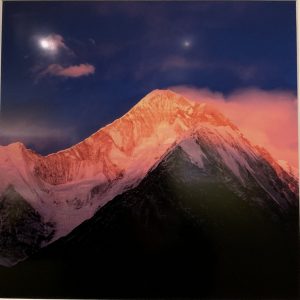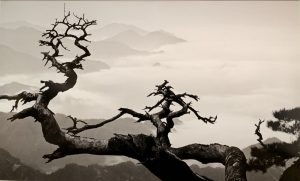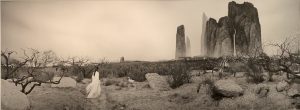Art of the Mountain: Through the Chinese Photographer’s Lens is a beautiful exhibition located at the China Institute. The exhibition features various photographers who captured various mountain range. Although all the photos displayed were very well composed, three of them in particular, stood out to me the most.
The first photo is Minyak Gangkar in the Last Night of the Sun by Zhang Anlu. The mountain photographed is a sacred mountain in Tibet. Zhang Anlu informs viewers about its dangerous and mysterious reputation. When I saw this photo the first thing I noticed was the contrast in colors. The mountaintop is a beautiful warm tone against a very cool sky. The mountain is easily separated from the sky due to the fact that orange and blue are complementary colors. Anlu also captured the part of the mountain that isn’t lit by the Sun. I assume he waits for the perfect moment to capture the fog that passes through this mountain. This is very smart because the fog compliments the mysterious nature of this mountain. The textures and grooves of the mountain are also shown by the snow that covers it. This is a very beautiful photo that is very well composed by Anlu.
The second photo that stood out to me was Huangshan A054 by Wang Wusheng. I think this is a beautiful photo simply because of the strong, dark organic shape against and very muted background. This photo reminds me of a sublime painting. The naked tree branch leads your eyes out into the mountains that stand behind it. The mountains are a lighter gray tone with fog surrounding it. I think the photographer may have wanted to capture other aspects of nature that surround these mountains such as trees. It almost gives off a feeling of mystery and serenity due to the rugged shape of the branch and calm fog that’s surrounds everything. I like this because the photographer manages to take your eyes to the mountains without making it the main subject of the photo.
Lastly, Peach Blossom Colony by Yang Yongliang. This photo is very interesting because it was manipulated by the artist to further develop his intended message. I think there are two subjects to this photo: the woman and the mountains. The woman is wearing a white dress and seems to be walking towards the mountains in the distance. The most interesting thing about this photo is when you look at it from a distance, it looks like a very calm scene. However, the closer you look, the more details you will start to notice. What I noticed were the mountains. The mountains are actually constructed from buildings. Some residential, some corporate. This is obviously done to spread a message. The photographer wants to show his viewers how society overtakes all the nature that is around us. All that is natural is slowly being destructed and more man-made materials are taking the place of nature. This photo is black and white. I think this is a very smart choice because it gives off a serious tone of voice which is what is needed for this pressing issue.







The color of the first photo you selected to discuss by Zhang Anlu is so lovely. And yes, it is about planning for and waiting for the right time of day, time of year, and weather.
As you point out in Huangshan A054 by Wang Wusheng, the mountain is not the main subject of the photo. It is really about the irregular shape of the tree. This photo also has less contrast than some of the other by this same photographer.
Peach Blossom Colony by Yang Yongliang is certainly a very interesting use of manipulated photography. The basic composition of the photo looks realistic. It is when you look closely that you see the mountains made of buildings. I agree that he was trying to communicate about the disruption of nature. I think he is also making a comment about contemporary China. The mountains is earlier Chinese pinging have a spiritual significance. That significance in his photo is replaced by development. So I think this may also be a comment about the materialism in the current culture.